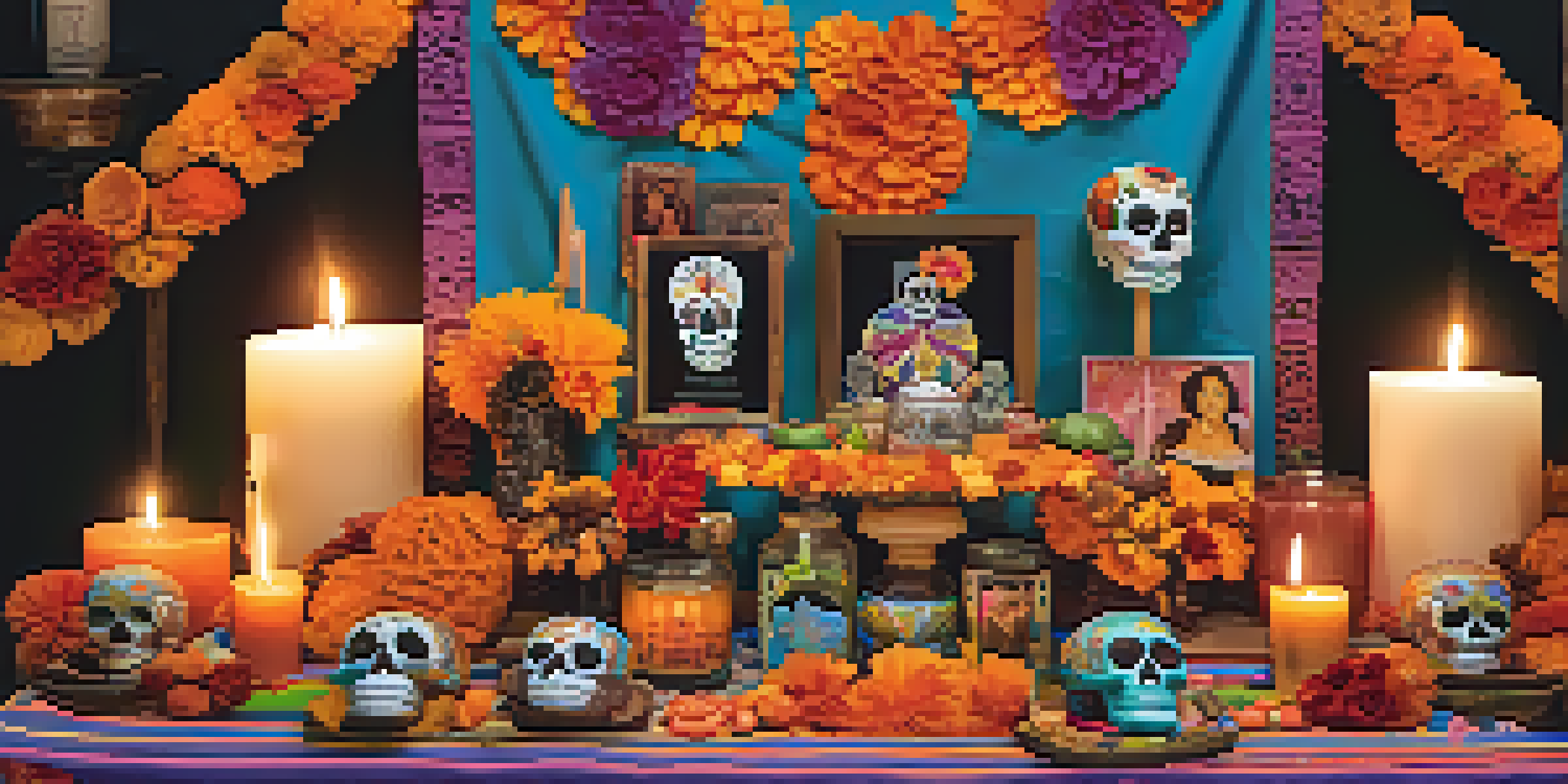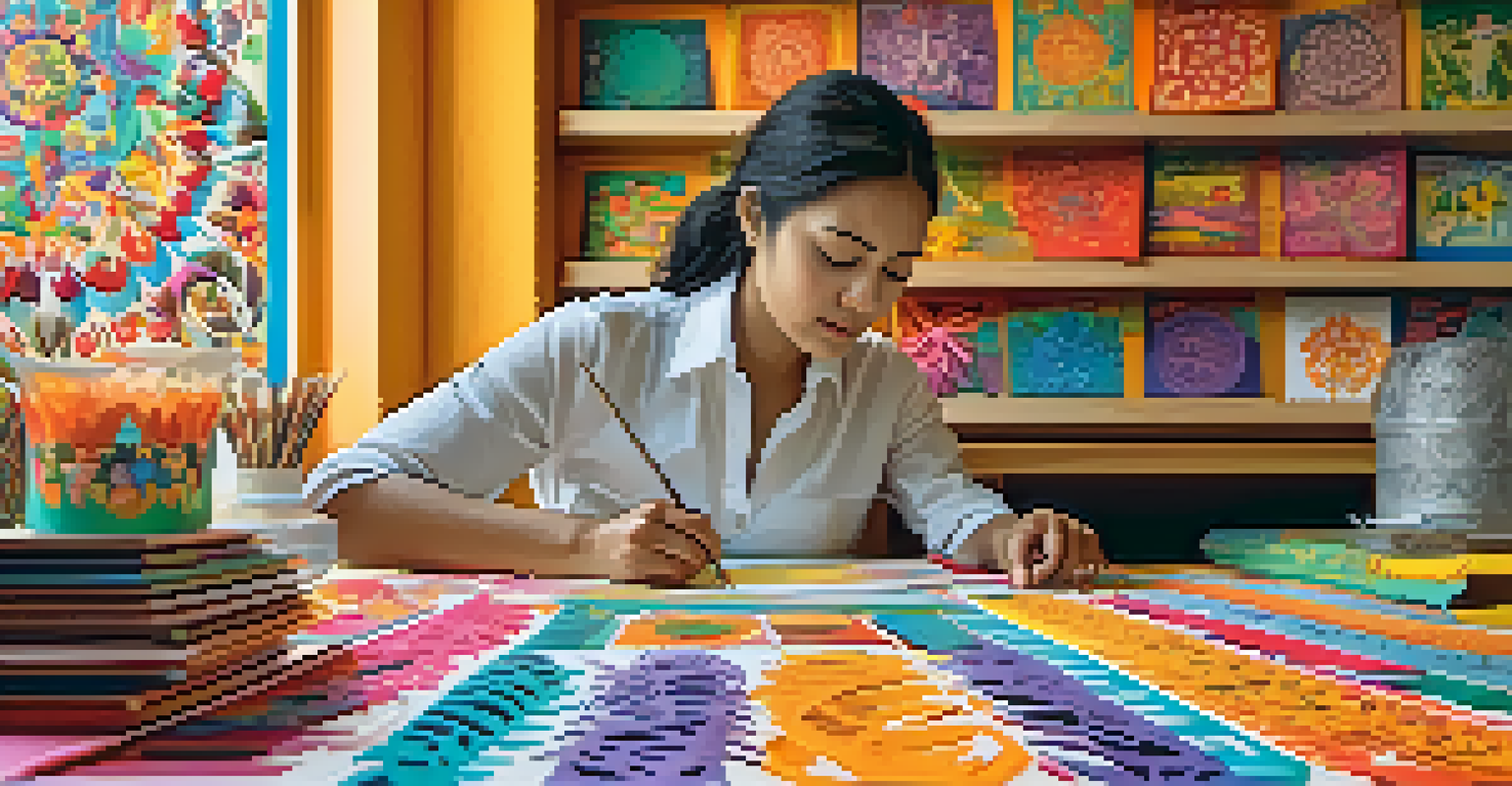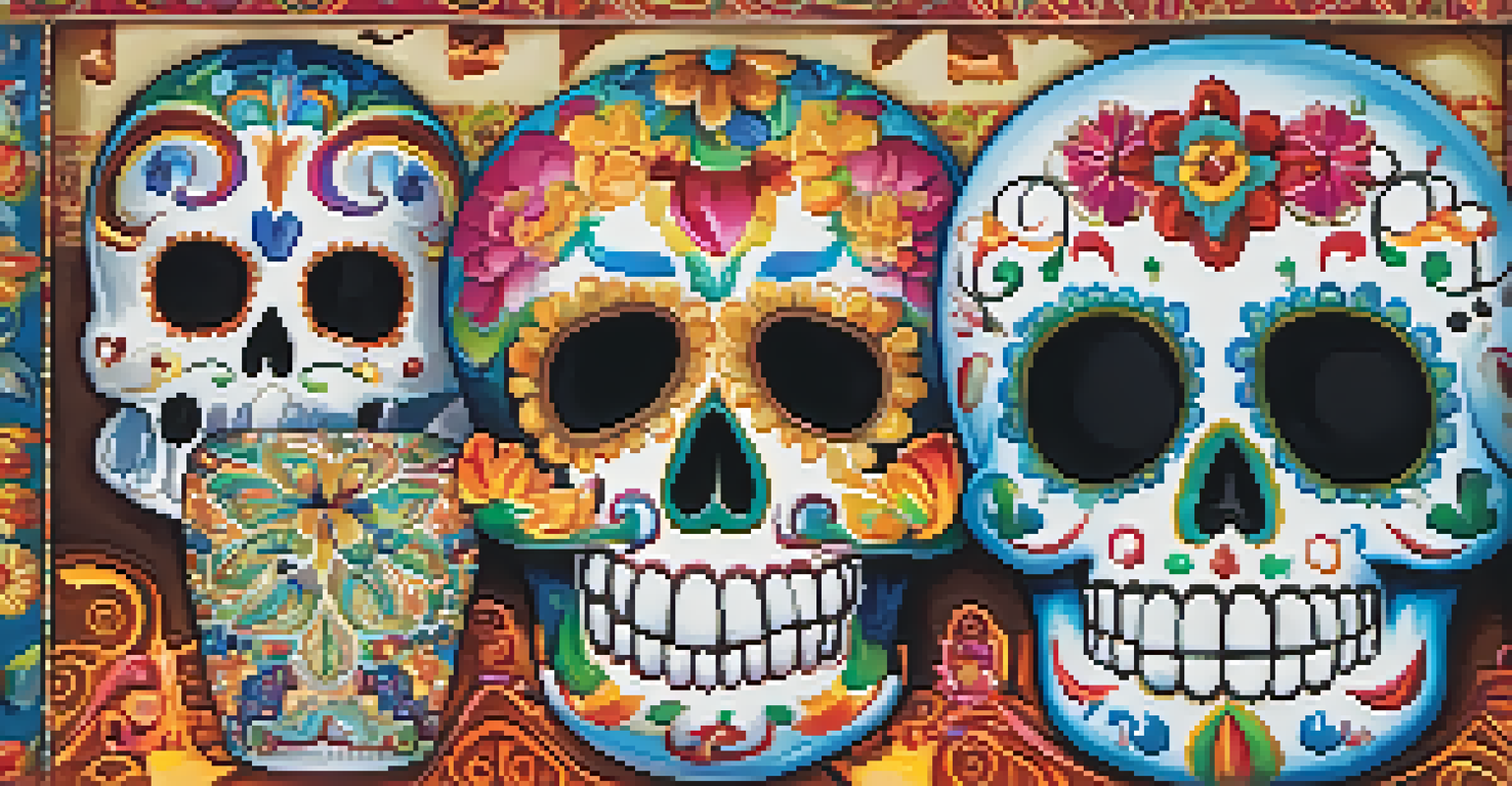The Symbolism of Art in Dia de Los Muertos Celebrations

Understanding Dia de Los Muertos: A Cultural Overview
Dia de Los Muertos, or Day of the Dead, is a vibrant Mexican tradition celebrated on November 1st and 2nd. It honors deceased loved ones, blending indigenous rituals with Spanish influences. This celebration is not about mourning but rather a joyous recognition of life and death.
To live in hearts we leave behind is not to die.
During this time, families create altars, known as ofrendas, adorned with photos, mementos, and favorite foods of the departed. The colorful decorations serve as a reminder that death is a part of life, and those who have passed are still with us in spirit. This cultural richness is reflected in every artistic element of the celebration.
Art plays a crucial role in expressing the themes of love, memory, and continuity. By understanding the cultural backdrop, we can appreciate how art becomes a medium for honoring and celebrating life even in the face of death.
The Role of Visual Art in Dia de Los Muertos
Visual art serves as a primary means of communication during Dia de Los Muertos. From intricate sugar skulls to papel picado (perforated paper), each piece holds significant meaning. These creations are not merely decorative; they embody the spirits of those we remember, making their presence felt in a tangible way.

For example, sugar skulls are often personalized with names and colorful designs, symbolizing the uniqueness of each individual. Meanwhile, papel picado, with its delicate patterns, represents the fragility of life. Such art forms invite families to engage in a dialogue about love and loss, creating a bridge between the living and the dead.
Celebration of Life and Death
Dia de Los Muertos joyfully honors deceased loved ones, blending cultural rituals to celebrate life alongside death.
Moreover, the use of vibrant colors signifies the joy of celebrating life. The visual art of Dia de Los Muertos transforms spaces into lively galleries that honor memories while embracing the beauty of existence.
Skulls: The Central Symbol in Dia de Los Muertos
Skulls are perhaps the most recognizable symbol of Dia de Los Muertos. Known as calaveras, they are often depicted in a playful manner, showcasing the celebration of life rather than fear of death. These artistic representations serve to remind us that death is not an end but a continuation of the cycle of life.
Death is nature's way of telling you to slow down.
The use of skulls in art can be traced back to ancient Mesoamerican cultures, where they held spiritual significance. Today, they are adorned with bright colors and intricate designs, symbolizing the individuality and legacy of those who have passed. This artistic approach helps to demystify death, making it a part of the natural human experience.
By embracing skulls as symbols of remembrance, artists encourage a broader understanding of death's role in life. This invites onlookers to reflect on their own relationships with mortality, fostering a sense of connection and appreciation for loved ones.
Papel Picado: The Art of Life and Death
Papel picado, the traditional Mexican craft of perforated paper, plays a vital role in Dia de Los Muertos celebrations. These beautifully crafted banners, often hung above altars, depict scenes of nature, life, and the afterlife. Their delicate designs symbolize the fragility of existence, reminding us of life's impermanence.
The act of creating papel picado is itself a form of honoring the deceased. Artisans meticulously cut patterns that reflect their personal stories and cultural heritage, weaving together history and memory. Each piece carries the weight of tradition, connecting generations through shared experiences.
Art as a Tribute and Healing
Visual art, such as sugar skulls and papel picado, serves as a powerful means of remembrance and emotional healing during the festivities.
Moreover, as the wind gently sways these vibrant banners, it serves as a metaphor for the connection between the living and the dead. This dynamic movement symbolizes the ongoing presence of those who have passed, reinforcing the idea that they are always with us in spirit.
Ofrendas: The Artistic Expression of Remembrance
Ofrendas are altars created to honor deceased loved ones, and they are often adorned with an array of artistic elements. Each altar is a unique creation, reflecting the personality and preferences of the departed. From photographs to handmade crafts, every item tells a story, making the ofrenda a deeply personal and artistic expression.
Families often incorporate favorite foods, drinks, and even toys to entice the spirits to join the celebration. The arrangement of these items is an art form in itself, requiring thoughtful consideration and creativity. This practice fosters a sense of connection and reverence, reminding the living of their loved ones’ legacies.
In this way, the ofrenda becomes a canvas for memories, bridging the gap between life and death. It showcases the beauty of recollection, allowing families to express their love and longing through artistic means.
The Influence of Folk Art in Dia de Los Muertos
Folk art is a significant component of Dia de Los Muertos celebrations, showcasing the creativity and traditions of local artisans. This form of art draws from everyday life, incorporating elements of culture, history, and personal stories. The handmade nature of folk art adds a unique touch, making each piece distinct and meaningful.
Artisans often use materials that hold cultural significance, such as clay, wood, and textiles, to create pieces that resonate with their communities. For example, wooden skeleton figurines, known as calacas, are painted in vibrant colors, reflecting the joyous spirit of the celebration. This connection to culture enhances the storytelling aspect of the festivities.
Personalized Altars of Remembrance
Ofrendas are uniquely crafted altars that reflect the personalities of the departed, turning memories into a vibrant artistic expression.
By embracing folk art, Dia de Los Muertos not only preserves traditions but also inspires new generations of artists. This continuous evolution of art ensures that the celebration remains relevant, allowing for personal interpretations while honoring the past.
Art as a Means of Healing in Dia de Los Muertos
Art serves as a powerful tool for healing during Dia de Los Muertos, allowing individuals to process grief and celebrate life. Creating art can be a cathartic experience, providing a safe space for expressing emotions related to loss. This practice fosters connection, helping families navigate their feelings while honoring their loved ones.
For many, participating in artistic activities, such as painting calacas or crafting papel picado, becomes a way to celebrate the lives of those who have passed. This shared experience can strengthen family bonds, encouraging open conversations about memories and feelings. Art becomes a collective act of remembrance, uniting generations.

Ultimately, the role of art in Dia de Los Muertos highlights the importance of embracing emotions surrounding death. It reminds us that grief can coexist with joy, creating a balanced perspective on life’s impermanence and the beauty of memories.